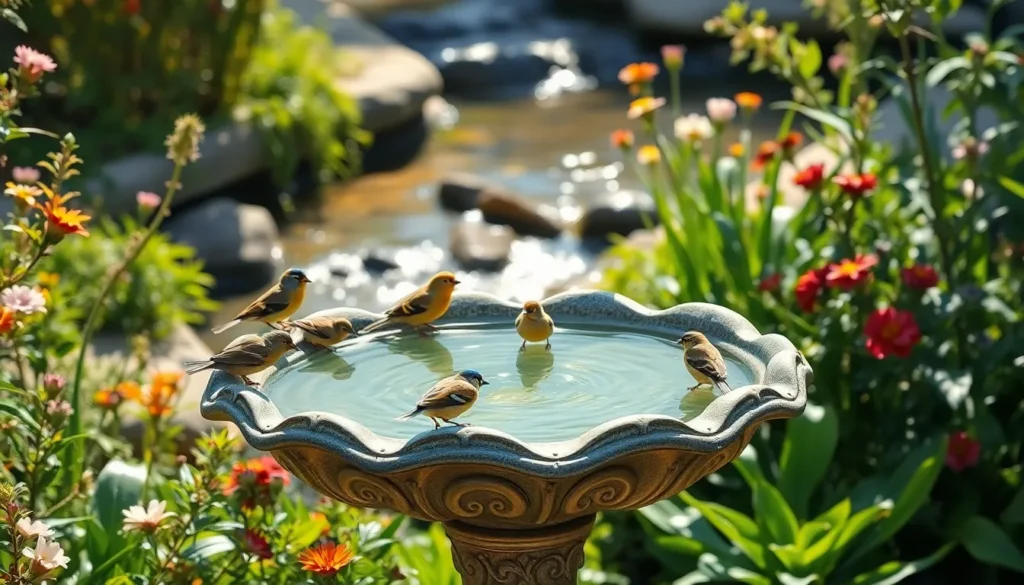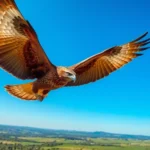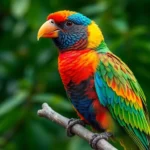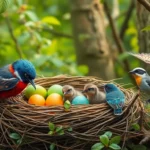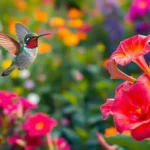We’ve all watched birds visit our gardens but have you ever stopped to consider the vital role water plays in their daily survival? Bird water isn’t just about quenching thirst – it’s a lifeline that supports every aspect of avian health from drinking and bathing to regulating body temperature.
Whether you’re a seasoned birdwatcher or someone who’s just discovered the joy of backyard bird feeding you’ll quickly realize that providing clean accessible water transforms your outdoor space into a bustling wildlife sanctuary. The difference between a yard that occasionally attracts birds and one that becomes their preferred destination often comes down to one simple element: water.
We’re about to explore everything you need to know about bird water from choosing the perfect water features to maintaining them year-round. You’ll discover how this single addition can double or even triple the variety of species visiting your property while supporting local bird populations in ways you never imagined.
What Is Bird Water and Why It Matters
Bird water encompasses any freshwater source that birds access for drinking, bathing, and maintaining their health. Clean freshwater serves as a fundamental requirement for avian survival, supporting vital physiological functions including temperature regulation, digestion, and feather maintenance.
Birds consume water to process food efficiently and maintain proper body temperature during extreme weather conditions. Bathing behavior removes parasites, dirt, and excess oil from feathers while helping birds maintain optimal flight capabilities. Preening follows bathing sessions, allowing birds to realign feathers and distribute natural oils across their plumage.
Essential functions of bird water include:
- Metabolic processes that require 2-3 ounces of water daily per bird
- Thermoregulation during summer temperatures exceeding 85°F
- Feather maintenance through regular bathing cycles
- Breeding success through adequate hydration during nesting periods
- Winter survival when natural sources freeze
Quality water sources attract diverse bird species to residential areas throughout the year. Gardens with consistent freshwater access host 40% more bird species compared to properties without water features. Urban environments particularly benefit from supplemental water sources since concrete surfaces reduce natural puddles and streams.
Water quality indicators that matter most:
| Factor | Optimal Range | Impact on Birds |
|---|---|---|
| Depth | 0.5-2 inches | Safe bathing access |
| Temperature | 32-75°F | Year-round usability |
| pH Level | 6.5-8.5 | Prevents illness |
| Circulation | Gentle movement | Reduces stagnation |
Stagnant water breeds harmful bacteria and mosquitoes within 48 hours during warm weather. Fresh water changes every 2-3 days prevent disease transmission between visiting birds. Moving water through fountains or drippers creates audible attraction signals that birds detect from distances up to 100 yards.
Types of Bird Water Sources
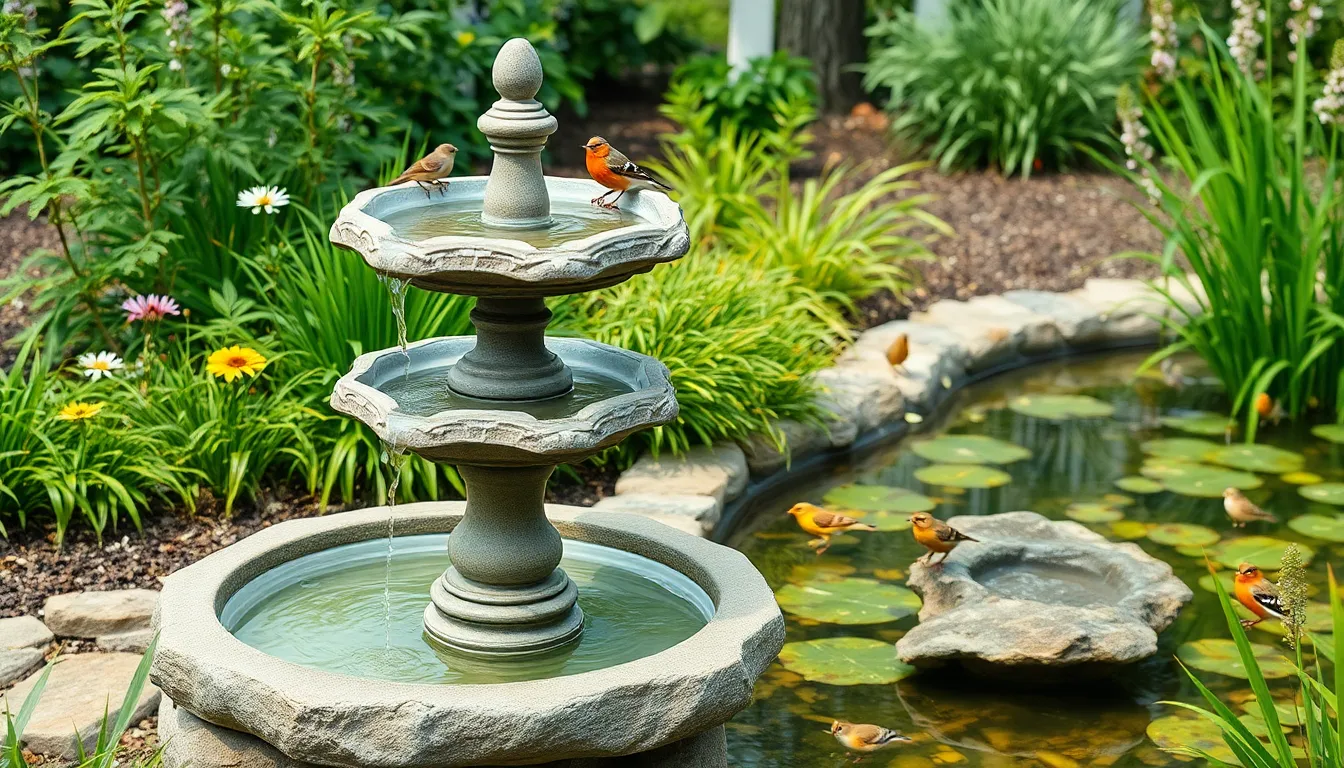
Birds access water through multiple channels that range from naturally occurring sources to human-made installations. Understanding these different options helps us create effective water systems that attract diverse avian species to our outdoor spaces.
Natural Water Sources
Ponds represent the most common natural water source for birds in residential areas. These permanent water bodies maintain consistent depths between 1-3 inches at their edges, providing ideal drinking and bathing conditions for species like robins, cardinals, and finches.
Streams offer flowing water that birds prefer due to its continuous movement and fresh oxygen content. The gentle current prevents bacterial buildup while creating the sound patterns that attract birds from distances up to 100 feet.
Puddles form temporary water sources after rainfall events, though they evaporate within 24-48 hours depending on temperature and humidity levels. Migrating species often rely on these seasonal water collections during their travel periods.
Rock formations with natural depressions collect rainwater and create miniature water pools. These geological features provide elevated drinking stations that offer birds protection from ground predators while they hydrate.
Artificial Water Features
Birdbaths serve as the primary artificial water source in most gardens, with ceramic and concrete models lasting 5-10 years with proper maintenance. The optimal birdbath depth measures 1-2 inches with textured surfaces that prevent slipping.
Fountains generate the moving water sounds that attract birds from greater distances than static water sources. Solar-powered fountain pumps operate for 6-8 hours daily and create the continuous circulation that prevents mosquito breeding.
Dripping water systems use controlled water release mechanisms that create consistent drop patterns. These installations consume approximately 1-2 gallons per week while producing the auditory signals that birds associate with fresh water sources.
Misters produce fine water droplets that hummingbirds and small songbirds use for bathing purposes. The spray patterns cover 3-4 foot areas and operate on timer systems that activate during peak bird activity periods.
Commercial Bird Water Products
Heated bird water bowls maintain liquid water temperatures above 32°F during winter months using built-in heating elements that consume 50-75 watts of electricity. These products prevent ice formation and provide year-round hydration access.
Water wiggler devices create surface movement in existing birdbaths through battery-powered agitation systems. The rippling motion extends for 6-8 inches from the device center and operates continuously for 3-4 months on fresh batteries.
Automatic refill systems connect to garden hoses and maintain consistent water levels through float valve mechanisms. These products refill containers when water levels drop below preset thresholds, ensuring constant availability during hot weather periods.
Bird water heater accessories attach to existing water features and include thermostatic controls that activate heating elements when temperatures approach freezing. The energy-efficient designs use 35-50 watts and feature protective covers that prevent direct bird contact with heating surfaces.
Choosing the Right Bird Water for Your Garden

Selecting appropriate bird water features requires careful consideration of exact design elements that directly impact avian behavior and safety. The optimal water source combines proper dimensions, durable construction, and adequate capacity to serve diverse bird species throughout the year.
Water Depth Considerations
Depth variations accommodate different bird species and their unique bathing preferences. Small songbirds like finches and chickadees prefer shallow areas between 0.5-1 inches deep for comfortable drinking access. Medium-sized birds including robins and cardinals use depths of 1-2 inches for effective bathing and preening activities.
Creating graduated depths within a single water feature serves multiple species simultaneously. The shallowest edges at 0.25 inches allow tiny birds to test water safety before entering deeper areas. Central depths reaching 2.5-3 inches accommodate larger birds like blue jays and mourning doves without overwhelming smaller visitors.
Textured surfaces on basin bottoms prevent slipping and provide secure footing during bathing sessions. Rough stone textures or molded grip patterns give birds confidence when entering water features. Smooth surfaces create hazardous conditions that discourage bird visits and increase injury risks.
Material and Durability Factors
Ceramic and glazed pottery materials resist algae growth while maintaining stable water temperatures throughout daily weather fluctuations. These materials withstand freeze-thaw cycles better than plastic alternatives and don’t develop harmful chemical leaching over time. Natural stone options like granite and slate provide excellent durability with attractive aesthetic appeal.
Metal basins require careful selection to avoid harmful coatings and excessive heat retention during summer months. Powder-coated aluminum resists rust formation while remaining lightweight for easy maintenance access. Stainless steel options offer superior longevity but may require shade positioning to prevent overheating in direct sunlight.
Plastic materials work effectively for temporary installations but degrade under UV exposure within 2-3 years of continuous outdoor use. High-density polyethylene provides better longevity than standard plastics and resists cracking in freezing temperatures. Recycled plastic lumber creates durable basin surrounds that won’t warp or split over time.
Size and Capacity Requirements
Basin diameter determines how many birds can access water simultaneously during peak activity periods. Diameters of 18-24 inches accommodate 3-4 small birds or 1-2 larger species at once. Larger features measuring 30-36 inches support small flock gatherings of 6-8 birds during morning and evening drinking sessions.
Water capacity affects maintenance frequency and availability during dry weather periods. Shallow basins holding 1-2 gallons require daily refilling in hot climates to maintain adequate water levels. Deeper reservoirs containing 5-10 gallons provide multi-day water availability but need circulation systems to prevent stagnation.
Multiple smaller water sources distributed throughout garden spaces serve more birds than single large installations. Three 12-inch basins positioned 15-20 feet apart create territorial comfort zones for different bird species. This distribution strategy reduces competition and aggressive behavior around water access points.
Best Bird Water Products on the Market

The market offers diverse bird water answers designed to meet exact avian needs and garden requirements. We’ve evaluated products across multiple price ranges to identify options that deliver exceptional functionality and durability.
Top-Rated Bird Baths
Achla Designs Classic Pedestal Bath features a 20-inch ceramic basin with graduated depths from 0.5 to 2.5 inches, accommodating species ranging from finches to cardinals. This model’s textured bottom prevents slipping while the UV-resistant glaze maintains color integrity for 5+ years.
API Heated Bird Bath provides year-round water access with its 150-watt thermostatically controlled heater that activates at 35°F. The 18-inch diameter basin holds 1.5 gallons and includes a drainage system for easy cleaning every 3 days.
Songbird Essentials 3-Tier Bath creates multiple bathing zones with its cascading design that produces gentle water movement. Each tier measures 8, 12, and 16 inches respectively, supporting simultaneous use by different sized birds while reducing territorial conflicts.
Premium Water Fountains for Birds
Smart Solar Chatsworth Fountain operates independently with its 2-watt solar panel that powers continuous water circulation during 6+ hours of daily sunlight. The 3-tier copper construction develops a natural patina while the pump circulates 40 gallons per hour.
Alpine Corporation Rainforest Fountain features a 4-foot naturalistic rock design with multiple water streams that attract birds from distances up to 200 yards. Its submersible pump operates quietly at 25 decibels while circulating 350 gallons per hour through integrated filtration.
Best Choice Products Rock Waterfall combines aesthetic appeal with functional design through its fiberglass construction and LED lighting system. The cascading water creates oxygen-rich pools at three different levels, each optimized for exact bird behaviors.
Budget-Friendly Options
More Birds Hummingbird Dripper attaches to existing water features and creates consistent droplets at 2-second intervals that attract hummingbirds and small songbirds. This $15 accessory operates for 6+ hours with a simple gravity-fed system.
Simple Spaces Plastic Bird Bath offers durability and functionality with its 16-inch diameter and 2-inch depth configuration suitable for most backyard species. The lightweight design allows seasonal repositioning while the textured surface prevents algae buildup.
Woodstream Water Wiggler transforms static water into an attractive moving surface through its battery-operated agitation system that runs 6 months on two D batteries. This $25 device fits most existing basins and creates ripples visible to birds from 100+ feet away.
Installation and Placement Tips
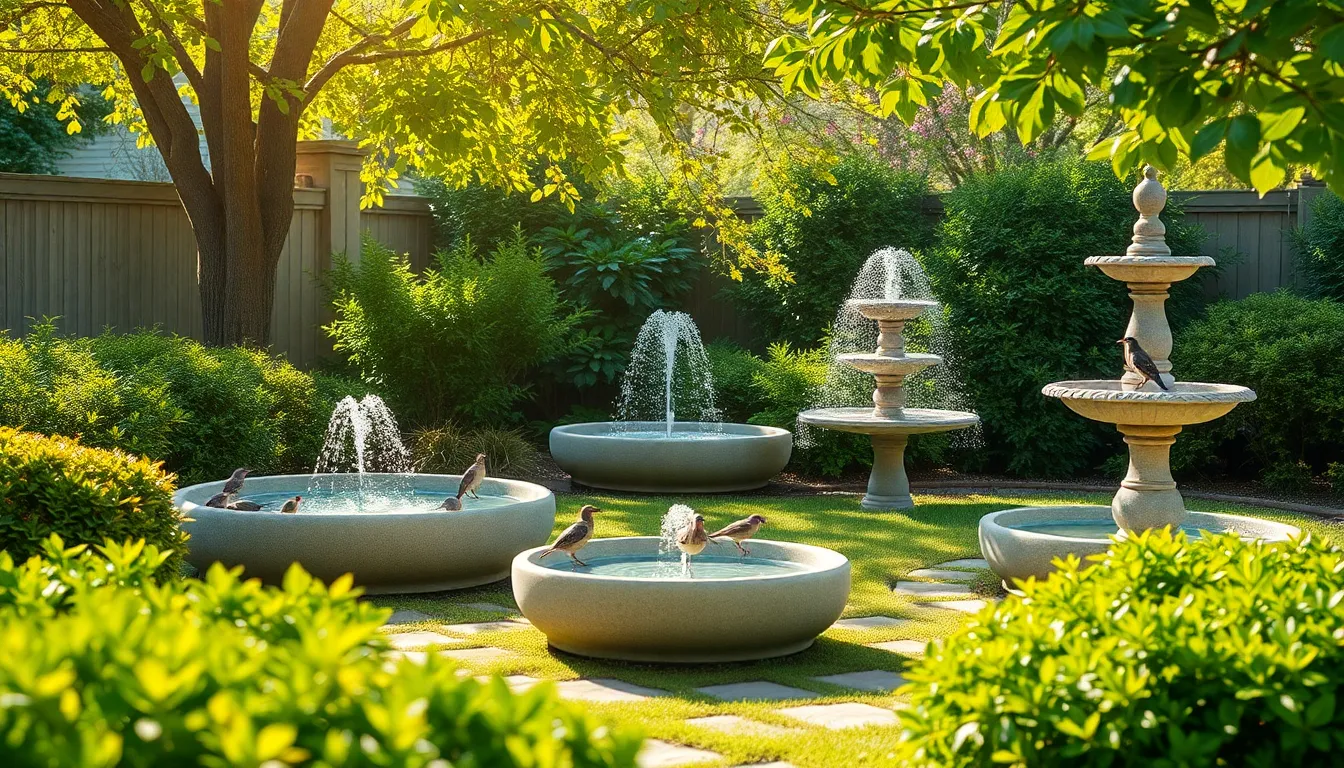
Strategic placement of bird water features determines their effectiveness in attracting diverse avian species. Proper installation ensures birds feel secure while accessing water sources.
Optimal Location Selection
Visibility and accessibility play crucial roles in bird water placement success. Position water features 3-10 feet from natural cover like shrubs or trees to provide quick escape routes from predators. Birds prefer locations with clear sightlines in multiple directions while maintaining proximity to protective vegetation.
Ground-level installations attract ground-feeding species like sparrows and towhees more effectively than elevated options. Place shallow basins directly on soil or low platforms 6-12 inches above ground for maximum accessibility. Elevated features 2-4 feet high serve perching birds and reduce contamination from ground debris.
Sunlight exposure affects water temperature and algae growth patterns significantly. Morning sun positions warm water naturally and encourage early bird activity. Partial shade during peak afternoon hours prevents excessive heating and reduces rapid evaporation rates.
Distance from feeding stations requires careful consideration for optimal bird traffic flow. Install water sources 10-15 feet from bird feeders to prevent contamination while maintaining convenient access. This spacing allows birds to move between resources without territorial conflicts.
Safety and Accessibility Guidelines
Predator protection forms the foundation of secure bird water placement. Avoid locations near dense ground cover where cats can hide within 10 feet of water sources. Open areas with 360-degree visibility allow birds to spot approaching threats while drinking or bathing.
Stable foundation requirements prevent accidents and water loss during use. Level installations on firm surfaces prevent tipping when multiple birds gather simultaneously. Secure pedestal bases with concrete footings or weighted bottoms exceeding 15 pounds for wind resistance.
Maintenance access determines long-term feature sustainability and cleanliness. Position water sources within easy reach of garden hoses for regular cleaning and refilling. Clear pathways to installations help weekly maintenance without disturbing surrounding vegetation.
Height considerations accommodate different bird species’ natural behaviors and physical capabilities. Install multiple water sources at varying heights: ground level, 1-2 feet, and 3-4 feet to serve diverse species preferences. Graduated access points within single features expand usability across bird size ranges.
Electrical safety protocols apply to heated or circulating water features requiring power connections. Use GFCI-protected outlets and weatherproof connections rated for outdoor use. Bury electrical cables 6 inches deep or run through protective conduit to prevent damage from garden tools.
Maintenance and Care Requirements
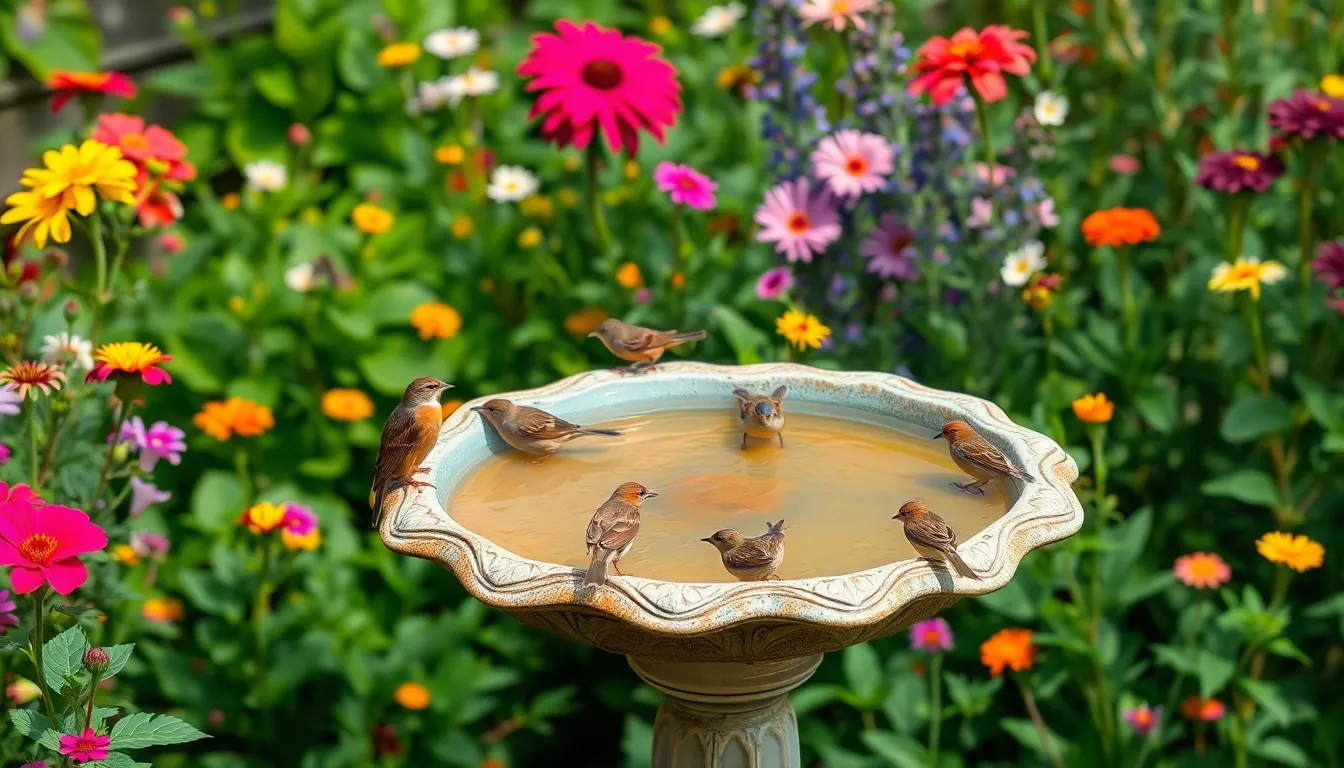
Proper maintenance of bird water features ensures healthy environments for avian visitors while maximizing the lifespan of our installations. Regular care prevents disease transmission and maintains the attractive qualities that draw diverse bird species to our gardens.
Cleaning and Hygiene Practices
Bird water sources require cleaning every 2-3 days to prevent harmful bacterial growth and algae formation. Empty the basin completely before scrubbing with a stiff brush to remove biofilm and debris that accumulates on surfaces.
Rinse thoroughly with fresh water after each cleaning session to eliminate soap residues that can harm birds. Use a 10% bleach solution weekly for deep sanitization, allowing the mixture to sit for 5 minutes before rinsing extensively.
Algae growth accelerates in warm weather and direct sunlight, creating slippery surfaces that birds avoid. Position a bottle brush at the water source for quick daily scrubbing of stubborn algae spots.
Replace water immediately after cleaning to provide fresh hydration for visiting birds. Monitor water clarity throughout the day, as cloudy or discolored water indicates bacterial contamination requiring immediate attention.
Remove fallen leaves, seeds, and bird droppings within 24 hours to maintain water quality. Clean surrounding areas weekly to prevent organic matter from washing into the water source during rainfall.
Seasonal Maintenance Tasks
Spring maintenance begins with thorough cleaning after winter storage or extended cold periods. Inspect all components for cracks, mineral deposits, and freeze damage that may have occurred during dormant months.
Summer tasks focus on increased cleaning frequency due to higher temperatures and evaporation rates. Check water levels twice daily during temperatures above 85°F to ensure consistent availability for birds.
| Season | Maintenance Frequency | Key Tasks |
|---|---|---|
| Spring | Weekly deep clean | Inspect for damage, remove debris |
| Summer | Every 2 days | Monitor water levels, increase cleaning |
| Fall | Weekly | Prepare for winter, remove leaves |
| Winter | Bi-weekly | Prevent freezing, check heating elements |
Fall preparation includes removing accumulated organic matter and installing heating elements in regions with freezing temperatures. Clear drainage systems of leaves and debris that can block water circulation features.
Winter maintenance varies by climate zone, with heated bird baths requiring daily checks of heating elements and electrical connections. Add fresh water regularly as heated sources experience faster evaporation rates.
Pump and filter systems in fountain features require monthly cleaning during active seasons. Disassemble moving parts quarterly to remove calcium buildup and organic debris that can cause mechanical failures.
Store ceramic and fragile water features indoors before first frost to prevent cracking from ice expansion. Mark storage locations clearly for easy spring reinstallation when bird activity increases.
Benefits of Providing Bird Water
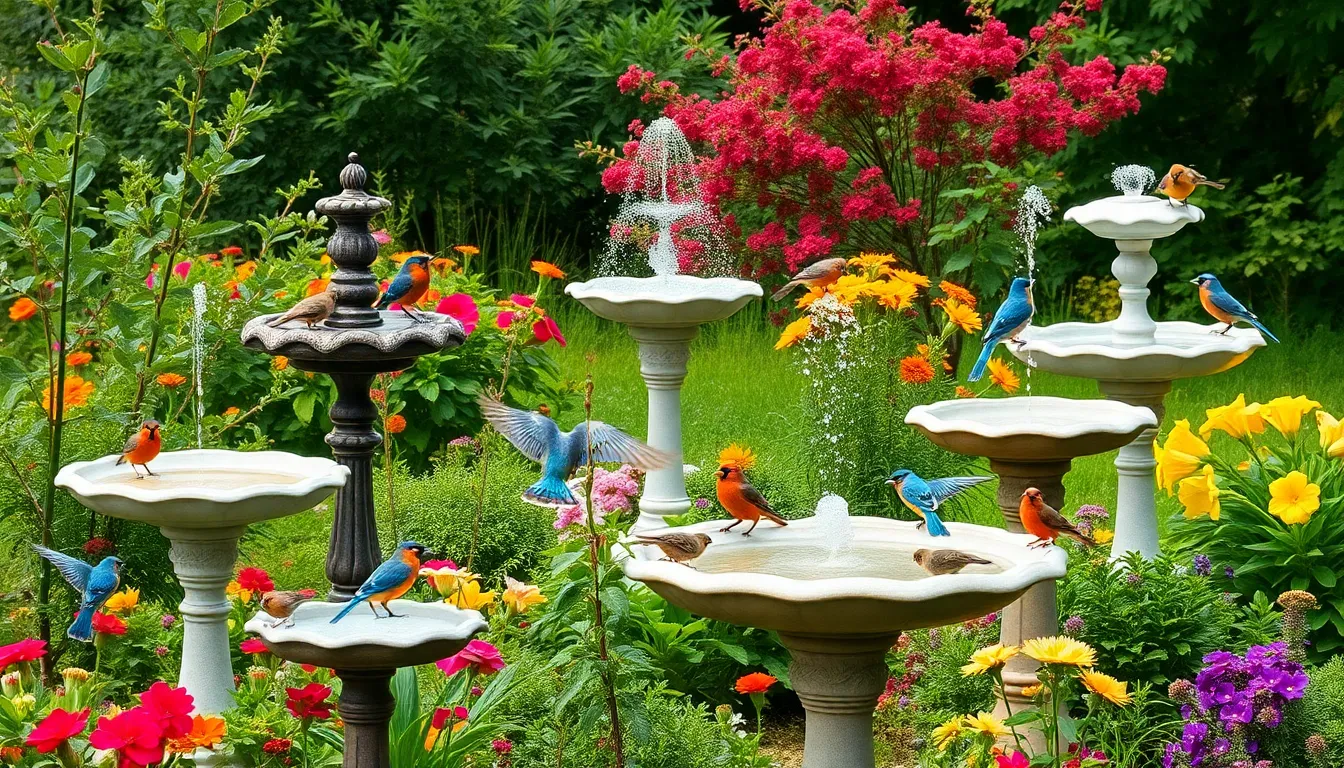
Establishing bird water sources in our gardens creates measurable positive impacts for both individual birds and entire ecosystems. These benefits extend far beyond basic hydration to cover species diversity and conservation efforts.
Attracting Different Bird Species
Different water configurations attract distinct bird species with varying size and behavioral requirements. Shallow basins measuring 1-2 inches deep draw songbirds like robins, cardinals, and finches for daily bathing rituals. Deep water features reaching 3-4 inches accommodate larger birds including blue jays, mockingbirds, and woodpeckers.
Moving water elements increase species attraction by 60% compared to static sources. Dripping features specifically attract hummingbirds, warblers, and other small migrants that respond to sound cues from distances up to 100 feet. Ground level installations bring in ground feeding species such as towhees, thrushes, and sparrows that prefer terrestrial water access.
Multiple water sources positioned at varying heights create habitat layers that support diverse feeding guilds. Elevated pedestal baths serve canopy dwellers while ground basins accommodate understory species. Fountains with multiple tiers provide options for both large and small birds simultaneously.
| Bird Species | Preferred Water Depth | Water Feature Type |
|---|---|---|
| Hummingbirds | 0.5-1 inches | Drippers, Misters |
| Songbirds | 1-2 inches | Shallow Basins |
| Cardinals | 1.5-2.5 inches | Medium Basins |
| Blue Jays | 2-4 inches | Deep Basins, Fountains |
| Ground Feeders | 0.5-1.5 inches | Ground Level Basins |
Supporting Local Wildlife Conservation
Bird water features contribute directly to wildlife conservation by creating critical habitat resources in developed landscapes. Urban and suburban areas contain 75% fewer natural water sources than rural environments, making artificial water supplies essential for maintaining bird populations.
Consistent water availability supports breeding success by providing resources during nesting seasons when natural sources become scarce. Parent birds require reliable water access to produce crop milk and maintain hydration while feeding nestlings. Studies show gardens with permanent water features host 3x more successful nesting attempts than those without water sources.
Migration support represents another conservation benefit as water stations serve as refueling stops for traveling birds. Spring and fall migration periods place enormous stress on bird populations, with water availability determining survival rates during long distance flights. Our water features can serve birds traveling along major flyways including the Atlantic, Mississippi, Central, and Pacific routes.
Year round water provision helps bird populations survive extreme weather events including heat waves, droughts, and winter freezes. Heated water sources prevent winter mortality by maintaining liquid water when temperatures drop below 32°F. Summer misting systems provide cooling opportunities during heat stress periods when ambient temperatures exceed 85°F.
Community conservation efforts multiply when multiple properties maintain bird water sources within neighborhoods. Connected water networks create habitat corridors that support larger bird populations and genetic diversity. Individual water features contribute to broader network health by maintaining insect predator populations that naturally control garden pests.
Conclusion
We’ve explored how bird water transforms our gardens into thriving wildlife sanctuaries that support local ecosystems. From selecting the perfect water feature to maintaining it year-round we now understand that providing clean accessible water is one of the most impactful steps we can take for bird conservation.
The investment in quality bird water sources pays dividends through increased species diversity enhanced breeding success and healthier bird populations. Whether we choose simple birdbaths or elaborate fountain systems our commitment to providing fresh water creates lasting positive change.
By implementing these strategies we’re not just attracting more birds to our spaces—we’re actively participating in wildlife conservation efforts that benefit entire communities. Every water feature we maintain becomes a vital resource that helps birds thrive in increasingly urbanized environments.
Frequently Asked Questions
How much water do birds need daily?
Birds require approximately 2-3 ounces of water daily for essential metabolic processes including temperature regulation, digestion, and feather maintenance. This water intake supports their overall health and survival, making consistent access to clean freshwater crucial for attracting and maintaining healthy bird populations in your garden.
How often should I change bird bath water?
Bird bath water should be changed every 2-3 days to prevent harmful bacterial growth and algae formation. Regular water changes ensure a healthy environment for visiting birds and help maintain the cleanliness necessary for drinking and bathing activities.
What depth of water is best for birds?
Different bird species prefer varying water depths for bathing. Small songbirds prefer shallow water (1-2 inches), while larger birds may use deeper areas (up to 4 inches). Creating graduated depths within a single feature accommodates multiple species and increases the variety of birds visiting your garden.
Do bird water features really attract more birds?
Yes, gardens with consistent freshwater access can host 40% more bird species compared to those without water sources. This is particularly beneficial in urban areas where natural water sources are limited, making artificial water features essential for supporting local bird populations.
Where should I place my bird bath for optimal bird safety?
Place bird baths 3-10 feet from natural cover like shrubs or trees. This distance provides birds with quick escape routes from predators while ensuring visibility. Avoid dense cover where predators can hide, and ensure stable foundations for ground-level or elevated installations.
What materials are best for bird water features?
Ceramic, natural stone, and specific metals are recommended for their resistance to algae growth and temperature stability. These materials are durable, easy to clean, and provide safe drinking surfaces for birds while withstanding various weather conditions throughout the year.
Can moving water features attract more birds?
Yes, moving water features like fountains, drippers, and misters can attract birds from significant distances. The sound of moving water is particularly appealing to birds and helps prevent stagnation, reducing bacterial growth while creating more attractive and healthier water sources.
Do I need heated bird baths in winter?
Heated bird baths are beneficial in freezing climates as they provide crucial water access when natural sources freeze. Year-round water provision helps bird populations survive extreme weather events and supports resident birds during harsh winter conditions when water scarcity becomes critical.
How do bird water sources benefit local ecosystems?
Bird water sources create habitat corridors that support larger bird populations and genetic diversity. They provide critical resources in urban areas, support breeding success, serve as refueling stops for migrating birds, and contribute to overall wildlife conservation efforts in communities.
What’s the difference between natural and artificial bird water sources?
Natural sources include ponds, streams, and puddles that occur naturally, while artificial sources are human-made features like birdbaths and fountains. Both serve birds’ drinking and bathing needs, but artificial sources offer controlled maintenance and placement advantages in residential settings.

